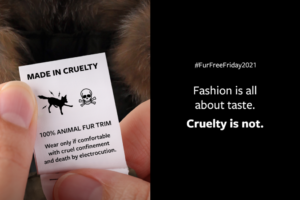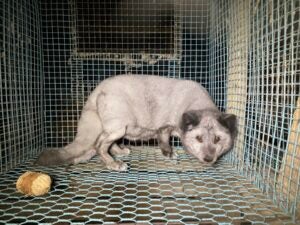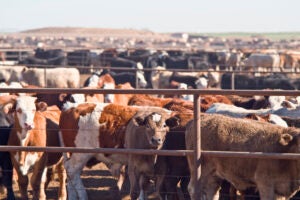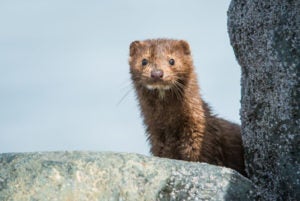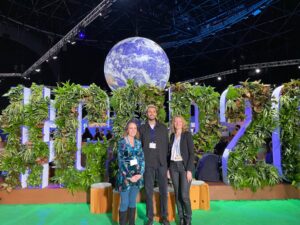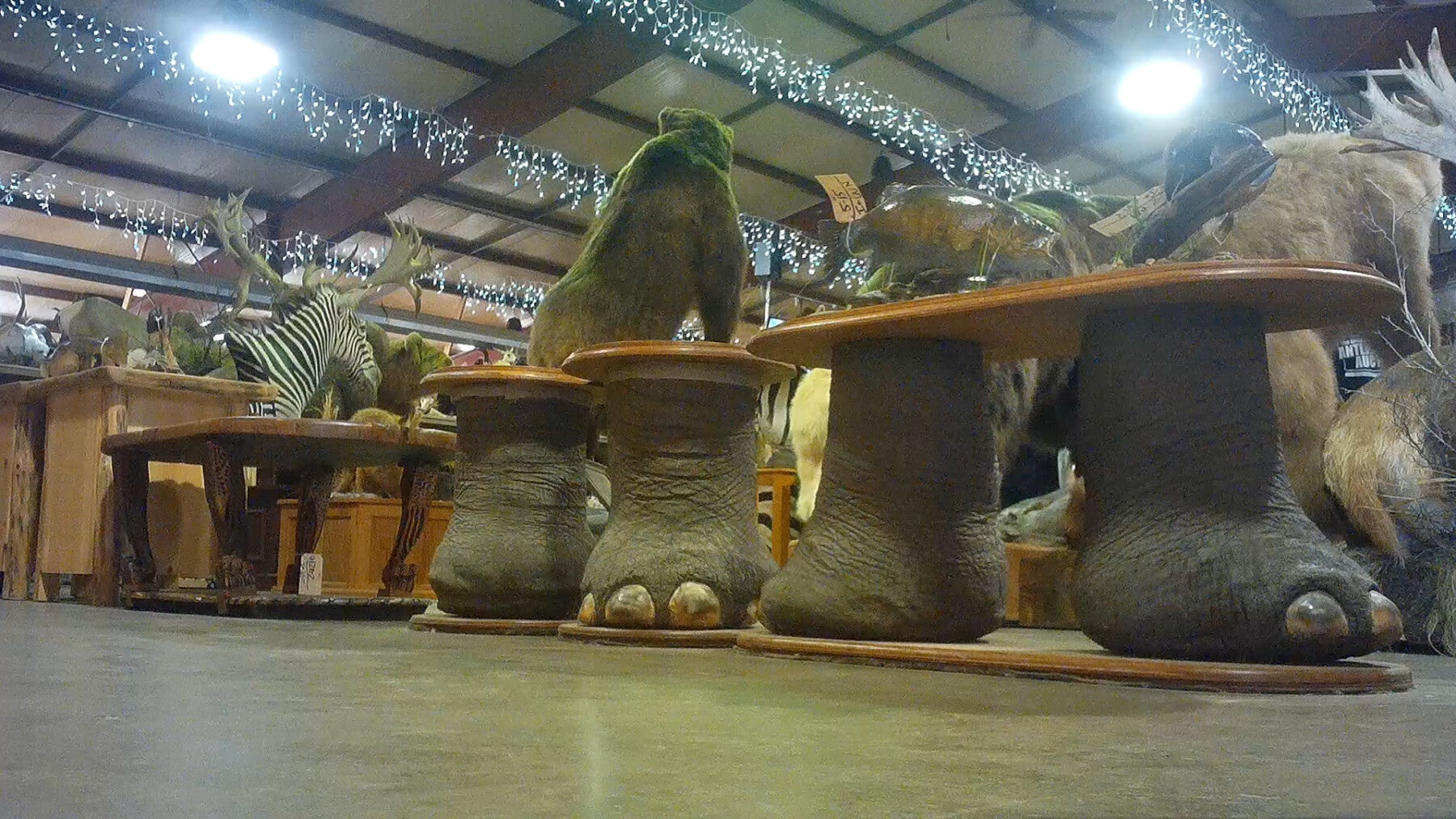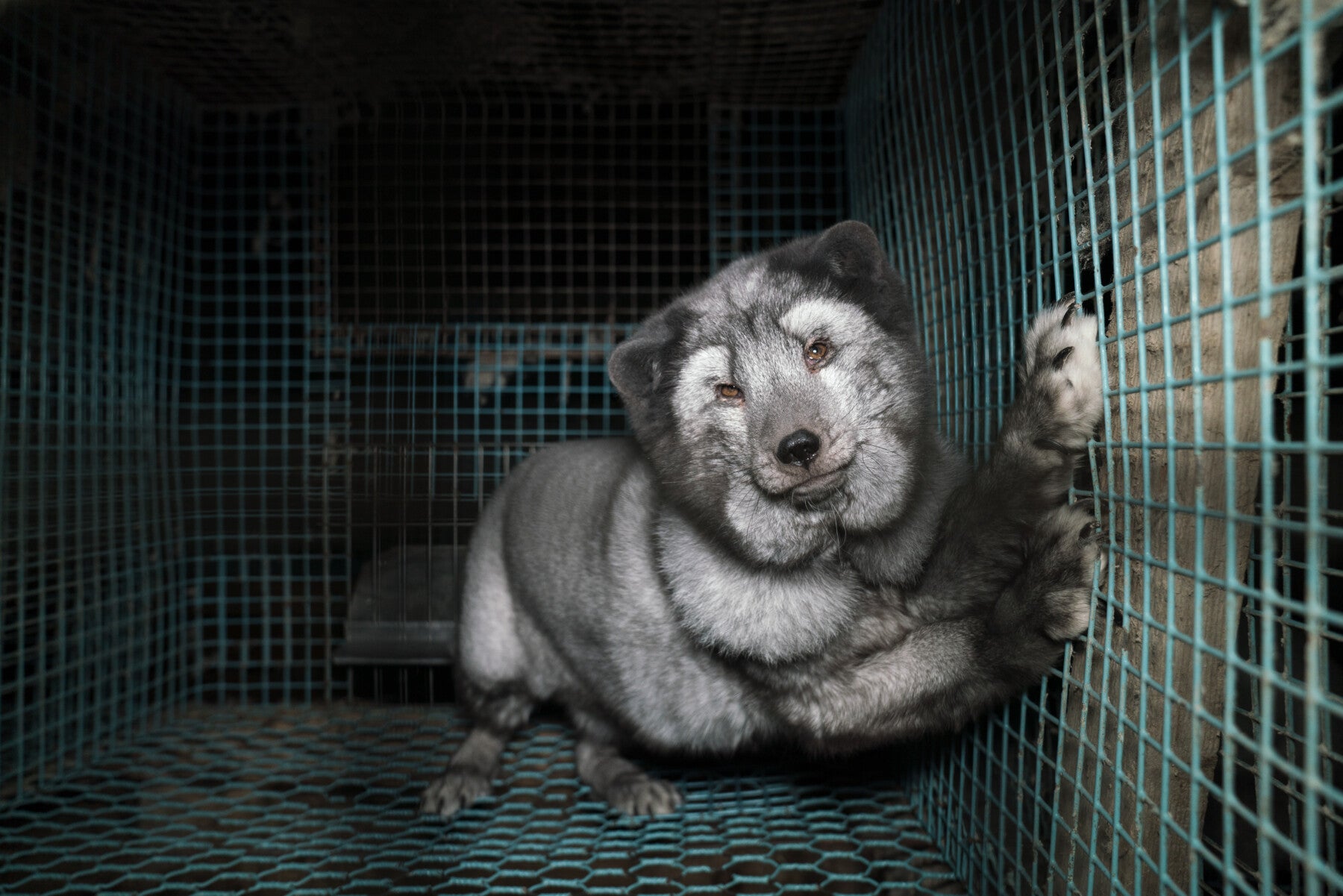
LONDON—Sales staff representing global designers Yves Salomon, Moncler and Max Mara in the fur salon at London’s Harrods department store, provided misleading information about conditions for animals on fur farms to a secret shopper filming for animal protection charity Humane Society International/UK. Sales staff for the fashion companies—all wearing Harrods-branded name badges—made misleading claims about the deprived environment in which caged animals are kept, and the way they are killed, when questioned about farmed fox fur from Finland.
The sales rep for Yves Salomon falsely claimed that foxes on fur farms are not kept in cages, telling the undercover customer that they are kept in “their own private space” in “separate rooms” “exactly” like Battersea (Dogs and Cats Home). The customer was repeatedly told that foxes are not kept in a cage and even that “they have enough space to play and everything”. In truth, the animals are confined in small, barren, wire factory-farm style cages one-metre squared. These pitiful conditions were exposed this week in HSI’s undercover investigation at three Finnish fox fur farms that showed animals in cages barely longer than their body length, nose to tail. Many of the foxes also suffered with deformed feet and diseased eyes.
Another Yves Salomon sales rep at Harrods gave HSI/UK’s undercover shopper the false assurance that before the animals are killed “they put them down with an injection” so that “they are literally put to sleep” when in truth foxes (and raccoon dogs) are anally electrocuted without any anaesthetic. When our shopper expressed concern about some videos she had seen of animals suffering in the fur trade she was told ‘it’s only propaganda, madam’.
Moncler’s sales assistant made the astonishing implication that its Finnish fox fur was just a by-product, saying “we take our fur from animals who were already taken for other purposes, like for example meat or something else”, despite the breeding of foxes for human consumption being illegal in the EU.
Humane Society International/UK which leads the #FurFreeBritain campaign for a UK fur sales ban, and Finnish animal campaigners Oikeutta Eläimille, visited three fur farms in the Ostrobothnia region of Finland, a country that has exported more than £11million of fur to the UK since 2000 despite the same fur farm cruelty being banned in the UK. Photos and video can be downloaded here. Filming took place in October 2021.
Claire Bass, executive director of Humane Society International/UK, who visited the fur farms, said: “It’s hardly a surprise that staff in Harrods don’t want to describe the grim reality of life for animals on fur farms, because it would surely leave their customers horrified. The week before speaking to five Harrods’ sales assistants who all creatively cloaked the cruelty of the fur trade, I visited several supposedly ‘high welfare’ Finnish fur farms and come face to face with the abject misery and suffering of thousands of foxes locked up in barren metre-squared battery cages their whole lives. Before Christmas they will all have been killed by anal electrocution, and the luxury lies of fur trade PR spin will market their lifeless fur to consumers.
The claim that fur farms are ‘like Battersea’, a rescue home for pets, was a whole new level of delusion. Fur farms and Battersea are like night and day in animal welfare terms. A Harrods manager’s claims that their fur is ‘ethically and sustainably sourced’ bears no scrutiny whatsoever. There is nothing ethical about any fur farming, certified or otherwise. We urge Harrods to stop peddling lies and stop selling fur cruelty. And the sooner the UK government bans the import and sale of animal fur, the sooner we can stop bankrolling this brutal industry.”
Max Mara’s sales staff told the investigator that its fur is certified by the fur trade’s SAGA Furs** assurance scheme which, they claimed, means “those ones are not cruel, not made in a cruel way…. It means that the animals don’t suffer.” However, at two SAGA Furs certified fox fur farms visited by HSI/UK, foxes with infected eyes and missing ears were filmed in woefully cramped cages, each one empty but for a single piece of wood or bone which passes for “enrichment”.
Fox fur originating from Finland is used by brands including Fendi, Moncler, Yves Salomon, Woolrich, Herno and Max Mara, and is seen in stores including Harrods, Harvey Nichols and Flannels.
Finland is the biggest producer of fox fur in Europe and the second biggest in the world, exporting millions of pounds worth of fur around the world including to the UK. Since banning fur farming in 2000 on ethical grounds, the UK has imported more than £850million of fur from a range of countries including France, Italy, Poland, China and the United States. Through its #FurFreeBritain campaign, HSI/UK is urging the government to end this by banning UK fur imports and sales, a move supported by 72% of the British public. The government is currently considering a fur sales ban and recently held a public consultation which received 30,000 responses.
HSI/UK has written to Harrods.
Please sign and share HSI’s petition calling for a UK fur sales ban: www.hsi.org/FurFreeBritain
Facts:
- More than 100 million animals are killed for their fur every year worldwide: foxes, raccoon dogs, mink, chinchilla and rabbits on fur farms and coyotes, beavers and other animals trapped in the wild—that’s equivalent to three animals dying every second, just for their fur. Finland rears and kills between 1-2 million foxes every year.
- Fur farming has been banned and/or is in the process of being phased out in 15 European countries including Austria, Belgium, the Netherlands, Norway, Slovakia, and the United Kingdom. The Republic of Ireland’s cabinet has approved legislation that would see fur farming banned from 2022; and legislation to ban mink farming is currently being debated by politicians in France. Bulgaria, Latvia, Lithuania, Spain and Ukraine are also considering proposals to ban fur farming.
- HSI/UK’s #FurFreeBritain campaign for a UK fur sales ban is supported by NGOs including the RSPCA, PETA UK and Four Paws UK, as well as celebrities including Sir Paul McCartney, Stella McCartney, Dame Judi Dench, Ricky Gervais and Leona Lewis.
- In 2021 Israel became the first country in the world to ban the sale of fur. Fur sales are also banned in the U.S. state of California, the cities of Los Angeles, San Francisco, Berkeley and West Hollywood, and the towns of Weston and Wellesley in Massachusetts and Ann Arbor in Michigan.
- Global fashion designers and retailers who have dropped fur cruelty include Canada Goose, Oscar de la Renta, Valentino, Gucci, Burberry, Versace, Chanel and Prada.
- A 2020 YouGov opinion poll reveals that 79% of Brits most closely associate fashion brands selling fur with negative words: ‘unethical’, ‘outdated’, ‘cruel’ and ‘out of touch’.
- Fur comes with a hefty environmental price tag. All fabrics have an eco-footprint, but when compared to others, fur scores badly in terms of the C02 emissions associated with keeping and feeding tens of thousands of carnivorous animals on a farm, the manure runoff into lakes and rivers, and the cocktail of toxic chemicals such as chromium and formaldehyde used to stop the fur and skin from rotting.
Media contact: Wendy Higgins: whiggins@hsi.org
Notes

